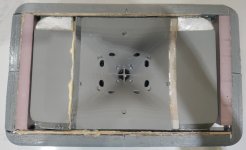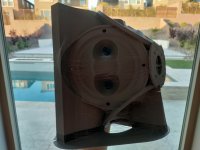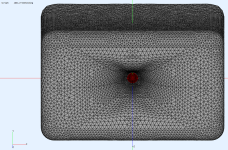Short update:
I tried to measure them outside with REW but there were two huge cancellations and I couldn't find what was causing them. Gateing didn't help, so after some tinkering I decided to try measuring them pointing upwards, as i remembered a nice youtuber was mentioning that as a trick (Auftrag Sound).
When pointed upwards, gating didn't change the anything in the meassured response, so I compared it with RTA and the data was similar. Setup new EQing and Delay in this configuration with RTA to have at least something done. Plan was to check the result with a sweep in REW, but i simply forgot to do that. Ups.
Something weird is happening in the higher frequencies. I didn't try to EQ it flat here, as I couldn't say for sure if its an artefact or if the response of the Compression Drivers is really that wavy. So for now, that is how it looks now in OpenSoundMeter (better measurements still pending):

I tried to measure them outside with REW but there were two huge cancellations and I couldn't find what was causing them. Gateing didn't help, so after some tinkering I decided to try measuring them pointing upwards, as i remembered a nice youtuber was mentioning that as a trick (Auftrag Sound).
When pointed upwards, gating didn't change the anything in the meassured response, so I compared it with RTA and the data was similar. Setup new EQing and Delay in this configuration with RTA to have at least something done. Plan was to check the result with a sweep in REW, but i simply forgot to do that. Ups.
Something weird is happening in the higher frequencies. I didn't try to EQ it flat here, as I couldn't say for sure if its an artefact or if the response of the Compression Drivers is really that wavy. So for now, that is how it looks now in OpenSoundMeter (better measurements still pending):
midrange taps are too close to throat.
To confirm, do a measurement of the tweeter alone. First with the taps uncovered, then covered.
Attached is a pic of my latest Unity horn, note how far the midrange taps are.
To confirm, do a measurement of the tweeter alone. First with the taps uncovered, then covered.
Attached is a pic of my latest Unity horn, note how far the midrange taps are.
Attachments
Hi!
That looks neat! Really nice!
I am confused about you saying the taps should be further out. doesn't that undermine the idea of using crossover frequencies within the horn loading at the specific location eg. circumfence smaller than the crossover frequency? Or do you sacrifice horn loading to avoid these dips?
I did the suggested measurements: Brown is with covered taps, blue is as manufactured.
You are right about that dip around 7-8kHz! I measured a difference of 3dB there, which is not that bad?
But that falloff is weird anyway, isn't it? Might be due to my measurement equipment and was similar in outdoor measurements.

Fullrange with EQ looks like the following. That doesn't look....nice? The dips that didn't appear outside and seem to be reflections, as they change when moving the whole setup around. At least i hope so.

So, what next? I don't think that I'll rebuild them based on these measurements, as I like the sound subjectively.
That looks neat! Really nice!
I am confused about you saying the taps should be further out. doesn't that undermine the idea of using crossover frequencies within the horn loading at the specific location eg. circumfence smaller than the crossover frequency? Or do you sacrifice horn loading to avoid these dips?
I did the suggested measurements: Brown is with covered taps, blue is as manufactured.
You are right about that dip around 7-8kHz! I measured a difference of 3dB there, which is not that bad?
But that falloff is weird anyway, isn't it? Might be due to my measurement equipment and was similar in outdoor measurements.
Fullrange with EQ looks like the following. That doesn't look....nice? The dips that didn't appear outside and seem to be reflections, as they change when moving the whole setup around. At least i hope so.
So, what next? I don't think that I'll rebuild them based on these measurements, as I like the sound subjectively.
In regards to your question -
For the most part, I don't really follow (most) of the Synergy and Unity horn rules any longer.
In particular:
1) I don't even bother to calculate the expansion ratio of the horn, so I couldn't tell you what it is where the midranges tap in. I don't care about midbass loading.
2) The main criteria that I look at is the driver to driver spacing between the midranges. If the spacing is too high, the horn won't work, you'll get a whole in the response between the midrange and the tweeter. I basically treat a Unity horn like an MTM speaker, but in three dimensions not one. In the commercial Danley speakers the midranges are generally a little tighter packed than mine are. In the Danley speakers, everything is within about 1/4 to 1/3 of a wavelength at the crossover point. IE, with a crossover point of about 1000Hz, the midranges and tweeter in a SH-50 are within about 8.5-11cm, which is 1/4 to 1/3 of a wavelength at the xover point. In my speakers, it's closer to about one half a wavelength. This is a little tricky because two speakers are out of phase if they're one half wavelength apart, so I have to be careful with the xover when I do this stunt. Basically delay at the xover point is a must, because I have to leverage delay to undo the damage that would be done if the four midranges and the tweeter were all on a flat baffle and wired in phase (you'd get a bunch of cancellations due to the pathlength differences.) But since I'm putting everything on a horn, there's various delays inherent in the design already, and those delays can be defects or features, depending on how you use them. In particular, the sharp rolloff of the midbasses introduces a delay which virtually moves the midrange backwards, as far as the crossover is concerned.
Stay tuned, I'll post some measurements of this speaker today which will help illustrate what I'm talking about.
For the most part, I don't really follow (most) of the Synergy and Unity horn rules any longer.
In particular:
1) I don't even bother to calculate the expansion ratio of the horn, so I couldn't tell you what it is where the midranges tap in. I don't care about midbass loading.
2) The main criteria that I look at is the driver to driver spacing between the midranges. If the spacing is too high, the horn won't work, you'll get a whole in the response between the midrange and the tweeter. I basically treat a Unity horn like an MTM speaker, but in three dimensions not one. In the commercial Danley speakers the midranges are generally a little tighter packed than mine are. In the Danley speakers, everything is within about 1/4 to 1/3 of a wavelength at the crossover point. IE, with a crossover point of about 1000Hz, the midranges and tweeter in a SH-50 are within about 8.5-11cm, which is 1/4 to 1/3 of a wavelength at the xover point. In my speakers, it's closer to about one half a wavelength. This is a little tricky because two speakers are out of phase if they're one half wavelength apart, so I have to be careful with the xover when I do this stunt. Basically delay at the xover point is a must, because I have to leverage delay to undo the damage that would be done if the four midranges and the tweeter were all on a flat baffle and wired in phase (you'd get a bunch of cancellations due to the pathlength differences.) But since I'm putting everything on a horn, there's various delays inherent in the design already, and those delays can be defects or features, depending on how you use them. In particular, the sharp rolloff of the midbasses introduces a delay which virtually moves the midrange backwards, as far as the crossover is concerned.
Stay tuned, I'll post some measurements of this speaker today which will help illustrate what I'm talking about.


